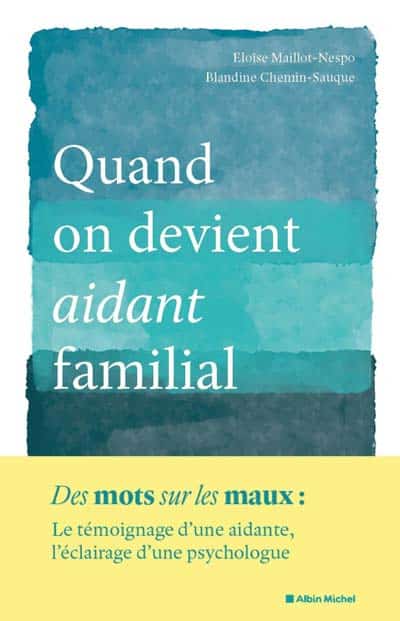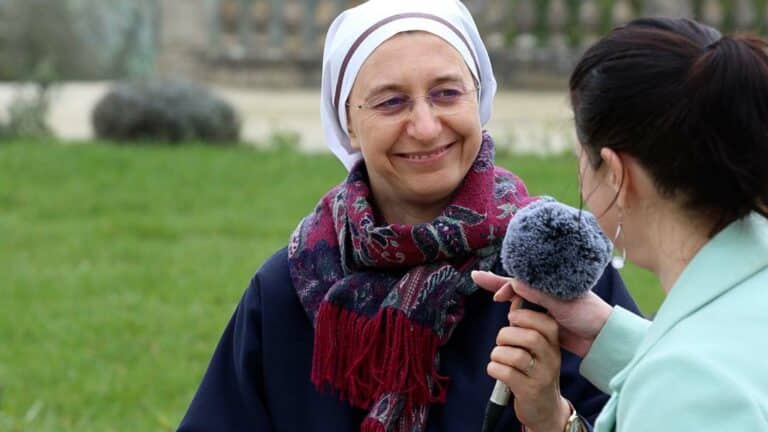Grief affects everyone, sooner or later. Yet, in a society where everything moves faster, where strong performance, faultless success and happiness are highly valued, death is the disturbing element. It stops the flow, shatters our bearings and makes us brutally aware of our vulnerability. We are no longer prepared to those stops in time. Slowness, silence or sorrow no longer have a space. Our relationships are often created as we act, or celebrate, or at work and the little amount of time left is lost watching screens. Paradoxically, bereavement becomes one of the last opportunity to reconnect with oneself.
As a clinician psychologist often interviewed in the media, Marie-Estelle Dupont helps people find words to express their suffering, acting as a counselor to help them go through the inner changes it causes. In her books — in particular Se délester du poids du passé [Throwing aside the weight of the past] (Eyrolles, 2024) —, she suggests a demanding but concrete task: observe, understand and act. Far from collective utopias, she recalls that a lever remains available to everyone, through taking care of oneself, step by step, day after day. “Engaging in psychotherapy amounts to changing the world”, she claims. Comforting people, she adds, does not mean numbing the pain but creating a space where it can be heard and then re-directed. Such is the purpose of this interview: informing the dynamics of grief and opening a sustainable path.
What is grief?
Grief starts when we loose a loved one, but it can also be symbolical, when an ordeal strips us from a part of ourselves. In her book published in 1969, On Death and Dying, Elisabeth Kübler-Ross describes five steps to grief, suggesting a series of emotions felt by terminally ill patients before their death. It is a process, not a condition, and the person goes through several steps: denial first, then anger, then bargaining, and finally – sometimes going back and forth many times – reaching acceptance and change. Tears, fatigue, loss of appetite or loss of interest for what people used to like in the past are normal reactions. They are not the result of a psychiatric disease. “Grieving is part of life”, reminds the psychologist. We are beings with ties and since death breaks those ties, it forces us to restore our inner order. Transferring the emotional load invested on the other person back to oneself then becomes vital. It requires time, respect and patience, some assets that our society tends to forget nowaday.
Grieving the death of a loved one
Marie-Estelle Dupont finds the phrase “Achieving the grieving process” irritating, because it reflects our obsession with control and results. “I prefer to say ‘Grieving the death of a loved one’,” she explains. In the past, people used to wear weeds. This outward sign helped them to name their ordeal. The loss of a child, for example, tears apart the natural order of things. “There will be a hole in the heart forever,” she says soberly. Yet life resumes its course, but differently. Some discover an inner light they had never known. Others shift their focus on essential things, or find a new form of spiritual connection with the deceased. It doesn’t replace physical presence, but it supports, comforts and makes possible a breath of fresh air, a continuity of love in another dimension.
How do you get through grief?
“How do I do it?” This question, often yelled, expresses the pain of those who can no longer find a grip. Yet, as Marie-Estelle Dupont reminds us, “we only transform what we accept”. Refusing to collapse means prolonging the pain. Sometimes, we have to agree to fall in order to get up again. Hyperactivity, distractions and compensations only delay healing. Accepting our slowness, acknowledging our powerlessness, is already moving forward. One morning, just managing to get out of bed or take a shower becomes a victory. Then, one day, without expecting it, a laugh comes along, and a drive returns. “Life is stubborn,” says Marie-Estelle with a smile. And this tenacity of life, discreet but real, traces the path back to oneself.
Inhabited solitude and inner dialogue with the deceased
Solitude has its place, it is not an enemy. On the contrary, it sifts memories: we look at photos and weep, keeping the best of the relationship. “It’s the linchpin of grief,” explains the psychologist. This transition from embodied presence to inner presence is the basis of a silent dialogue: What would s/he have said to me? How would s/he have reacted? Little by little, this dialogue brings relief. At the same time, the relationships get readjusted. Some friends drift away, unable to cope with the grief; others reveal themselves, offering unexpected support. This rearrangement of the emotional circle is part of the process. We must also beware of the pitfalls of guilt, particularly in siblings, where survivor syndrome can arise. The remaining child must understand that he or she does not have to live “for two”, and is not expected to take over the expectations placed on the deceased child. Their own life retains their legitimacy and freedom. What’s more, we avoid living the life of the deceased “by proxy”. This melancholy drift should be a cause for alarm. It calls for professional help.
Rites and gestures that help
What can be done? Funeral rites support and honor memory. They inscribe filiation, recognizing the continuity of life across generations. To do away with them is to deny the humanity of the bond. Each of us can invent simple actions, such as completing a project left unfinished, writing a letter, recounting the life of the deceased to his or her children.
“When we pray, we receive answers,” confides Marie-Estelle Dupont. Prayer, especially in cases of traumatic bereavement such as suicide, becomes a place of truth and reconciliation. It allows us to ask for or offer forgiveness, even long after the fact. Conversely, wanting to “live in the other person’s place” maintains the illusion and prevents healing. A sober, faithful tribute, adjusted to the passage of time, enables us to move forward without betraying love.
The grieving process in conflicted relationships
The grieving process in conflicted circumstances can be more painful than when the relationship is harmonious. Absence precludes direct reconciliation. As a result, anger turns against oneself. “The most difficult forgiveness is often self-forgiveness,” stresses the psychologist. It’s a matter of recognizing the gray zones, such as fear, resignation, dependence. In assaulted women, for example, absolving the aggressor is not the challenge, it is to dare to forgive themselves, to recognize themselves as worthy of respectful love.
Naming the fault, finding words for the wound, writing, praying: each uttered word is a step towards freedom. This very personal work puts the relationship back in its rightful place – finite, of course, but full of lessons to be learned. These wounds can also be entrusted in prayer, where a path to freedom then opens up.
.

“Pin up some pictures, pray and you’ll get something much better than any montage with an artificial voice.”
Why does separation hurt so much?
The frightening thing about death is not so much the idea of disappearing as the idea of being separated. Children understand this intuitively. They don’t fear their own death, but that of a beloved grandmother, a guardian figure of tenderness, stability and transmission. These women, often because they got impacted by the trials of the century, embody a form of silent, courageous dignity. Their disappearance awakens the anguish of having to leave or loose something. The night reveals this, and sometimes sleep disturbances show it. Our unconscious, however, knows nothing of death: it just keeps the link alive in dreams. Consequently, the grieving process consists in incorporating this shared “we” into our own identity. As a result, we talk to reassure. We use rites to maintain our bearings. We reconnect to our integrity, and learn to live with what’s missing. In the case of a missing child, this journey takes on a deeply moving dimension: “You are reborn from their ashes”, asserts Marie-Estelle Dupont. The wound is never completely closed, but it is transformed, and life eventually goes back to normal.
Turning to the Virgin Mary rather than to chatbots…
Entrusting a deceased person to the Virgin Mary touches even those who claim to be far removed from the faith. The symbol of the Pietà, a mother holding the body of her son across her lap, speaks for itself: she consents to the unbearable and hands over to God what she cannot hold back. It is a gesture of love and trust. Conversely, certain technologies – chatbots that imitate the voices of the dead – promise a mockery of presence and maintain a dangerous confusion between the real and the imaginary worlds. “It’s all a sham,” warns the psychologist. Grieving is already a precarious construction, so it cannot be sustained with lies. True memory is woven into prayer, in true recollection, not simulation. At this particularly stage, a lasting, peaceful inner dialogue takes place.
About family caregivers
Assisting a loved one to the end is a trial of love. It is an exhausting and costly task, sometimes leading to discouragement. “Yet, many people regret that they were not present”, insists Marie-Estelle. They have received a lesson in humanity, they have experienced unforgettable words, they have loved to the end. After this, their grief turns into a special experience, since it follows a time of intense osmosis and leaves a great emptiness. People are dazed by the brutality of the interruption and are at risk to experience prolonged grief disorder, especially when they are isolated.
In those days, the close family members, the doctors, the priests, play an essential part. Héloïse Maillot-Nespo & Blandine Chemin-Sauque’s Book, Quand on devient aidant familial [Becoming a family caregiver] (Albin Michel), gives a truthful testimony of this. Understanding that giving oneself does not mean sacrificing one’s life is liberating. You may have given yourself without loosing yourself and find your peace for having given your all.
When her mum who had cancer lost her independence, Éloïse Maillot-Nespo suddenly found herself in the position of the caregiver. She tried to address some questions: How can I be both her daughter and her caregiver? How can I protect myself? How can overcome grief after such deep ties to a loved one?
Bereavement creates wounds, separation, obligations. However, the relationship is not broken by it. Bit by bit, an inner dialogue takes place, day after day. It becomes a source of faithfulness, of presence and life. “The pain subsides and the presence remains, in different terms”, explains Marie-Estelle Dupont. Going through grief means stepping forward on that invisible thread between absence and memory, with the certainty that loving does not go away. Together, we can support this step-by-step process, gently and respectfully. Also in prayer, if you so wish.




